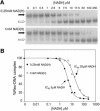A novel sensor of NADH/NAD+ redox poise in Streptomyces coelicolor A3(2)
- PMID: 12970197
- PMCID: PMC212721
- DOI: 10.1093/emboj/cdg453
A novel sensor of NADH/NAD+ redox poise in Streptomyces coelicolor A3(2)
Abstract
We describe the identification of Rex, a novel redox-sensing repressor that appears to be widespread among Gram-positive bacteria. In Streptomyces coelicolor Rex binds to operator (ROP) sites located upstream of several respiratory genes, including the cydABCD and rex-hemACD operons. The DNA-binding activity of Rex appears to be controlled by the redox poise of the NADH/NAD+ pool. Using electromobility shift and surface plasmon resonance assays we show that NADH, but not NAD+, inhibits the DNA-binding activity of Rex. However, NAD+ competes with NADH for Rex binding, allowing Rex to sense redox poise over a range of NAD(H) concentrations. Rex is predicted to include a pyridine nucleotide-binding domain (Rossmann fold), and residues that might play key structural and nucleotide binding roles are highly conserved. In support of this, the central glycine in the signature motif (GlyXGlyXXGly) is shown to be essential for redox sensing. Rex homologues exist in most Gram-positive bacteria, including human pathogens such as Staphylococcus aureus, Listeria monocytogenes and Streptococcus pneumoniae.
Figures









Similar articles
-
X-ray structure of a Rex-family repressor/NADH complex insights into the mechanism of redox sensing.Structure. 2005 Jan;13(1):43-54. doi: 10.1016/j.str.2004.10.012. Structure. 2005. PMID: 15642260
-
[Cloning and expression of the redox-sensing transcriptional repressor Rex and in vitro DNA-binding assay of the Rex and rex operator in Streptomyces rimosus M4018].Wei Sheng Wu Xue Bao. 2012 Jan;52(1):38-43. Wei Sheng Wu Xue Bao. 2012. PMID: 22489458 Chinese.
-
Structural basis for NADH/NAD+ redox sensing by a Rex family repressor.Mol Cell. 2010 May 28;38(4):563-75. doi: 10.1016/j.molcel.2010.05.006. Mol Cell. 2010. PMID: 20513431
-
Transcription factor Rex in regulation of pathophysiology in oral pathogens.Mol Oral Microbiol. 2016 Apr;31(2):115-24. doi: 10.1111/omi.12114. Epub 2015 Aug 6. Mol Oral Microbiol. 2016. PMID: 26172563 Free PMC article. Review.
-
Sense and sensor ability: redox-responsive regulators in Listeria monocytogenes.Curr Opin Microbiol. 2019 Feb;47:20-25. doi: 10.1016/j.mib.2018.10.006. Epub 2018 Nov 6. Curr Opin Microbiol. 2019. PMID: 30412828 Free PMC article. Review.
Cited by
-
The Onset of Tacrolimus Biosynthesis in Streptomyces tsukubaensis Is Dependent on the Intracellular Redox Status.Antibiotics (Basel). 2020 Oct 15;9(10):703. doi: 10.3390/antibiotics9100703. Antibiotics (Basel). 2020. PMID: 33076498 Free PMC article.
-
Comparative Proteomic Analysis of Transcriptional and Regulatory Proteins Abundances in S. lividans and S. coelicolor Suggests a Link between Various Stresses and Antibiotic Production.Int J Mol Sci. 2022 Nov 26;23(23):14792. doi: 10.3390/ijms232314792. Int J Mol Sci. 2022. PMID: 36499130 Free PMC article.
-
Cytochrome bd Oxidase Has an Important Role in Sustaining Growth and Development of Streptomyces coelicolor A3(2) under Oxygen-Limiting Conditions.J Bacteriol. 2018 Jul 25;200(16):e00239-18. doi: 10.1128/JB.00239-18. Print 2018 Aug 15. J Bacteriol. 2018. PMID: 29784883 Free PMC article.
-
Real-time assessment of the metabolic profile of living cells with genetically encoded NADH sensors.Methods Enzymol. 2014;542:349-67. doi: 10.1016/B978-0-12-416618-9.00018-2. Methods Enzymol. 2014. PMID: 24862275 Free PMC article.
-
Rex (encoded by DVU_0916) in Desulfovibrio vulgaris Hildenborough is a repressor of sulfate adenylyl transferase and is regulated by NADH.J Bacteriol. 2015 Jan 1;197(1):29-39. doi: 10.1128/JB.02083-14. Epub 2014 Oct 13. J Bacteriol. 2015. PMID: 25313388 Free PMC article.
References
-
- Baker P.J., Britton,K.L., Rice,D.W., Rob,A. and Stillman,T.J. (1992) Structural consequences of sequence patterns in the fingerprint region of the nucleotide binding fold. Implications for nucleotide specificity. J. Mol. Biol., 228, 662–671. - PubMed
-
- Bentley S.D. et al. (2002) Complete genome sequence of the model actinomycete Streptomyces coelicolor A3(2) Nature, 417, 141–147. - PubMed
-
- Bierman M., Logan,R., O’Brien,K., Seno,E.T., Rao,R.N. and Schoner,B.E. (1992) Plasmid cloning vectors for the conjugal transfer of DNA from Escherichia coli to Streptomyces spp. Gene, 116, 43–49. - PubMed
Publication types
MeSH terms
Substances
LinkOut - more resources
Full Text Sources
Other Literature Sources
Molecular Biology Databases

